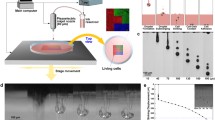Abstract
Bacterial cells were patterned efficiently on a nutrient-coated membrane in a direct, rapid, and cost-effective manner using electro-hydrodynamically generated micro-droplets. By varying the viscosity and electrical conductivity of the bacterial printing solution, uniform droplets were obtained. Escherichia coli cells were directly printed onto a membrane filter, followed by overnight incubation on an agar plate which created line patterns of bacterial colonies with a width of approximately 160 μm. Optimization of the concentration of the chemical components [i.e. the ethylene glycol (EG), phosphate buffer (PB), and sodium chloride (NaCl)] in the processing bacterial solution allowed successful growth and patterning of the cells. The optimal conditions to achieve the most effective cell growth and patterning on these printed surfaces were an EG concentration of 40 vol% and a concentration as low as 10 mM of PB or NaCl in the printing solution. Cells passing through the electric nozzle during the printing process remained viable.









Similar content being viewed by others
References
Ahmad Z, Thian ES, Huang J, Edirisinghe MJ, Best SM, Jayasinghe SN, Bonfield W, Brooks RA, Rushton N (2008) Deposition of nano-hydroxyapatite particles utilising direct and transitional electrohydrodynamic processes. J Mater Sci Mater Med 19:3093–3104
Avseenko NV, Morozova TY, Ataullakhanov FI, Morozov VN (2002) Immunoassay with multicomponent protein microarrays fabricated by electrospray deposition. Anal Chem 74:927–933
Bhatia SN, Yarmush ML, Toner M (1997) Controlling cell interactions by micropatterning in co-cultures: Hepatocytes and 3T3 fibroblasts. J Biomed Mater Res 34:189–199
Chen CH, Saville DA, Aksay IA (2006) Electrohydrodynamic “drop-and-place” particle deployment. Appl Phys Lett 88:154104
Dertinger SKW, Chiu DT, Jeon NL, Whitesides GM (2001) Generation of gradients having complex shapes using microfluidic networks. Anal Chem 73:1240–1246
Duggan DJ, Bittner M, Chen Y, Meltzer P, Trent JM (1999) Expression profiling using cDNA microarrays. Nat Genet 21:10–14
Gupta A, Seifalian AM, Ahmad Z, Edirisinghe MJ, Winslet MC (2007) Novel electrohydrodynamic printing of nanocomposite biopolymer scaffolds. J Bioact Compat Polym 22:265–280
Jayasinghe SN, Eagles PAM (2006) Electric field driven jetting: an emerging approach for processing living cells. Biotechnol J 1:86–94
Jayasinghe SN, Edrisinghe MJ (2002) Effect of viscosity on the size of relics produced by electrostatic atomization. J Aerosol Sci 33:1379–1388
Jayasinghe SN, Edrisinghe MJ, Wilde TD (2002) A novel ceramic printing technique based on electrostatic atomization of a suspension. Mater Res Innovations 6:92–95
Kim J, Yamagata Y, Kim B, Higuchi T (2004) Micro patterning of fluorescent nanoparticles by atomizers combined with electrostatic deposition and stencil mask. In: 17th IEEE international conference on Micro Electro Mechanical Systems (MEMS 2004), Maastricht, The Netherlands, IEEE, New York, pp 625–628, 25–29 Jan 2004
Kim HS, Lee DY, Park JH, Kim JH, Hwang J, Jung HI (2007) Optimization of electorhydrodynamic writing technique to print collagen. Exp Tech 31:15–19
Lee DY, Hwang ES, Yu TU, Kim YJ, Hwang J (2006a) Structuring of micro line conductor using electro-hydrodynamic printing of a silver nanoparticle suspension. Appl Phys A 82:671–674
Lee JG, Cho HJ, Huh N, Ko C, Lee WC, Jang YH, Lee BS, Kang IS, Choi JW (2006b) Electrohydrodynamic (EHD) dispensing of nanoliter DNA droplets for microarrays. Biosens Bioelectron 21:2240–2247
Lee DY, Shin YS, Park SE, Yu TU, Hwang J (2007) Electrohydrodynamic printing of silver nanoparticles by using a focused nanocolloid jet. Appl Phys Lett 90:081905
Liu VA, Jastromb WE, Bhatia SN (2002) Engineering protein and cell adhesivity using PEO-terminated triblock polymers. J Biomed Mater Res 60:126–134
Loscertales IG, Barrero A, Guerrero I, Cortijo R, Marquez M, Gañán-Calvo AM (2002) Micro/nano encapsulation via electrified coaxial liquid jets. Science 295:1695–1698
Morozov VN, Morozova TY (1999) Electrospray deposition as a method to fabricate functionally active protein films. Anal Chem 71:1415–1420
Mrksich M, Dike LE, Tien J, Ingber DE, Whitesides GM (1997) Using microcontact printing to pattern the attachment of mammalian cells to self-assembled monolayers of alkanethiolates on transparent films of gold and silver. Exp Cell Res 235:305–313
Roth EA, Xu T, Das M, Gregory C, Hickman JJ, Boland T (2004) Inkjet printing for high-throuput cell patterning. Biomaterials 25:3707–3715
Stankus JJ, Guan J, Fujimoto K, Wagner WR (2006) Microintegrating smooth muscle cells into a biodegradable, elastomeric fiber matrix. Biomaterials 27:735–744
Takayama S, Mcdonald JC, Ostuni E, Liang MN, Kenis PJA, Ismagilov RF, Whidtesides GM (1999) Patterning cells and their environments using multiple laminar flows in capillary networks. Proc Natl Acad Sci USA 96:5545–5548
Thirumalapura NR, Ramachandran A, Morton RJ, Malayer JR (2006) Bacterial cell microarrays for the detection and characterization of antibodies against surface antigens. J Immunol Methods 309:48–54
Wang DZ, Jayasinghe SN, Edirisinghe MJ (2005) High resolution print-patterning of a nano-suspension. J Nanopart Res 3:301–306
Xu T, Petridou S, Lee EH, Roth EA, Vyavahare NR, Hickman JJ, Boland T (2004) Construction of high-density bacterial colony arrays and patterns by the ink-jet Method. Biotechnol Bioeng 85:29–33
Xu T, Jin J, Gregory C, Hickman JJ, Boland T (2005) Inkjet imprinting of viable mammalian cells. Biomaterials 26:93–99
Xu L, Robert L, Ouyang Q, Taddei F, Chen Y, Lindner AB, Baigl D (2007) Microcontact printing of living bacteria arrays with cellular resolution. Nano Lett 7:2068–2072
Acknowledgments
This work was supported by a grant from the Korea Research Foundation Grant (KRF-2006-331-D00040) funded by the Korean Government (MOEHRD), a grant from the ICBIN of the Seoul R&BD program (Grant no. 10816), and a grant from the National Core Research Center (NCRC) for Nanomedical Technology of the Korea Science & Engineering Foundation (Grant no. R15-2004-024-01001-0).
Author information
Authors and Affiliations
Corresponding author
Rights and permissions
About this article
Cite this article
Kim, JH., Lee, DY., Hwang, J. et al. Direct pattern formation of bacterial cells using micro-droplets generated by electrohydrodynamic forces. Microfluid Nanofluid 7, 829 (2009). https://doi.org/10.1007/s10404-009-0441-6
Received:
Accepted:
Published:
DOI: https://doi.org/10.1007/s10404-009-0441-6




